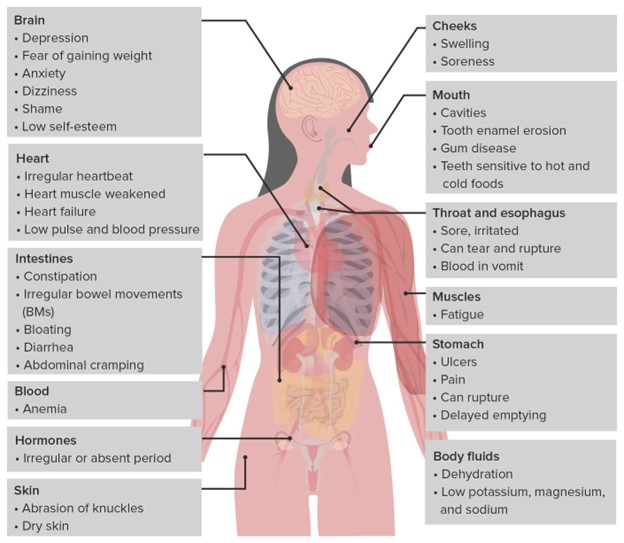A community health nurse is developing a brochure about hypertension.
Which of the following actions should the nurse take?
Write the information at an 8th-grade reading level
Present information from complex to simple
Explain medical terminology using basic, one-syllable words
Use a 12-point font size
Correct Answer : A
A. Write the information at an 8th-grade reading level: This is a good practice. Writing at an 8th-grade reading level ensures that the brochure is understandable for a wide audience, including those with varying levels of literacy. It helps make the information clear and accessible.
B. Present information from complex to simple: This approach is not ideal. It is generally more effective to present information from simple to complex to build understanding progressively. Starting with basic concepts helps the reader grasp foundational information before moving to more detailed content.
C. Explain medical terminology using basic, one-syllable words: While using simple language is important, basic, one-syllable words might not always be appropriate for explaining medical terminology accurately. It is better to use plain language that conveys the meaning clearly, rather than overly simplifying complex terms.
D. Use a 12-point font size: Using a 12-point font size is generally appropriate and readable for most brochures. However, depending on the audience, a slightly larger font size (e.g., 14-point) may be preferable to enhance readability.
Nursing Test Bank
Naxlex Comprehensive Predictor Exams
Related Questions
Correct Answer is A
Explanation
Ensuring the device is kept below the level of the client's chest is important to ensure that the drainage system functions properly by allowing the fluid and air to flow downhill. Placing the device below the level of the chest helps facilitate gravity drainage.

Continuous suction is required for proper functioning of the chest tube drainage system. Clamping the chest tube can disrupt the suction and impede the removal of air or fluid from the pleural space. Only in specific circumstances, such as when changing the drainage system or assessing for air leaks, may the healthcare provider request a temporary clamping of the chest tube.
Positioning the client semi-Fowler's, with the head of the bed elevated, can help promote lung expansion and improve oxygenation. The specific positioning may vary depending on the client's condition and the healthcare provider's recommendations.
The nurse should empty the collection chamber as per the facility's protocol, which typically includes monitoring the drainage and emptying it when it reaches a certain level. Regular emptying of the collection chamber helps maintain proper functioning of the chest tube system and allows for accurate measurement of drainage output.
Correct Answer is A
Explanation
Observing the client during and after meals is crucial for monitoring their eating behaviors, identifying any signs of bingeing or purging, and assessing their overall progress in managing their eating disorder. By closely observing the client, the nurse can provide immediate support and intervention if necessary and help prevent or address any potentially harmful behaviors. Instructing the client about effective coping strategies is valuable in helping them develop healthier ways to manage stress and emotions. However, this instruction can be more effective once the nurse has observed the client's behaviors and identified specific areas where coping strategies are needed.
Suggesting that the client assist with meal planning can be a helpful step in empowering them to take ownership of their eating habits and make healthier choices. However, before involving the client in meal planning, it is important to first assess their current eating behaviors and address any immediate concerns or risks.
Referring the client to a support group for individuals with eating disorders is a beneficial step in providing ongoing support and community. However, this referral can be made once the nurse has established a baseline understanding of the client's behaviors and needs.
Observing the client during and after meals is crucial for monitoring their eating behaviors, identifying any signs of bingeing or purging, and assessing their overall progress in managing their eating disorder. By closely observing the client, the nurse can provide immediate support and intervention if necessary and help prevent or address any potentially harmful behaviors. Instructing the client about effective coping strategies is valuable in helping them develop healthier ways to manage stress and emotions. However, this instruction can be more effective once the nurse has observed the client's behaviors and identified specific areas where coping strategies are needed.
Suggesting that the client assist with meal planning can be a helpful step in empowering them to take ownership of their eating habits and make healthier choices. However, before involving the client in meal planning, it is important to first assess their current eating behaviors and address any immediate concerns or risks.
Referring the client to a support group for individuals with eating disorders is a beneficial step in providing ongoing support and community. However, this referral can be made once the nurse has established a baseline understanding of the client's behaviors and needs.

Whether you are a student looking to ace your exams or a practicing nurse seeking to enhance your expertise , our nursing education contents will empower you with the confidence and competence to make a difference in the lives of patients and become a respected leader in the healthcare field.
Visit Naxlex, invest in your future and unlock endless possibilities with our unparalleled nursing education contents today
Report Wrong Answer on the Current Question
Do you disagree with the answer? If yes, what is your expected answer? Explain.
Kindly be descriptive with the issue you are facing.
